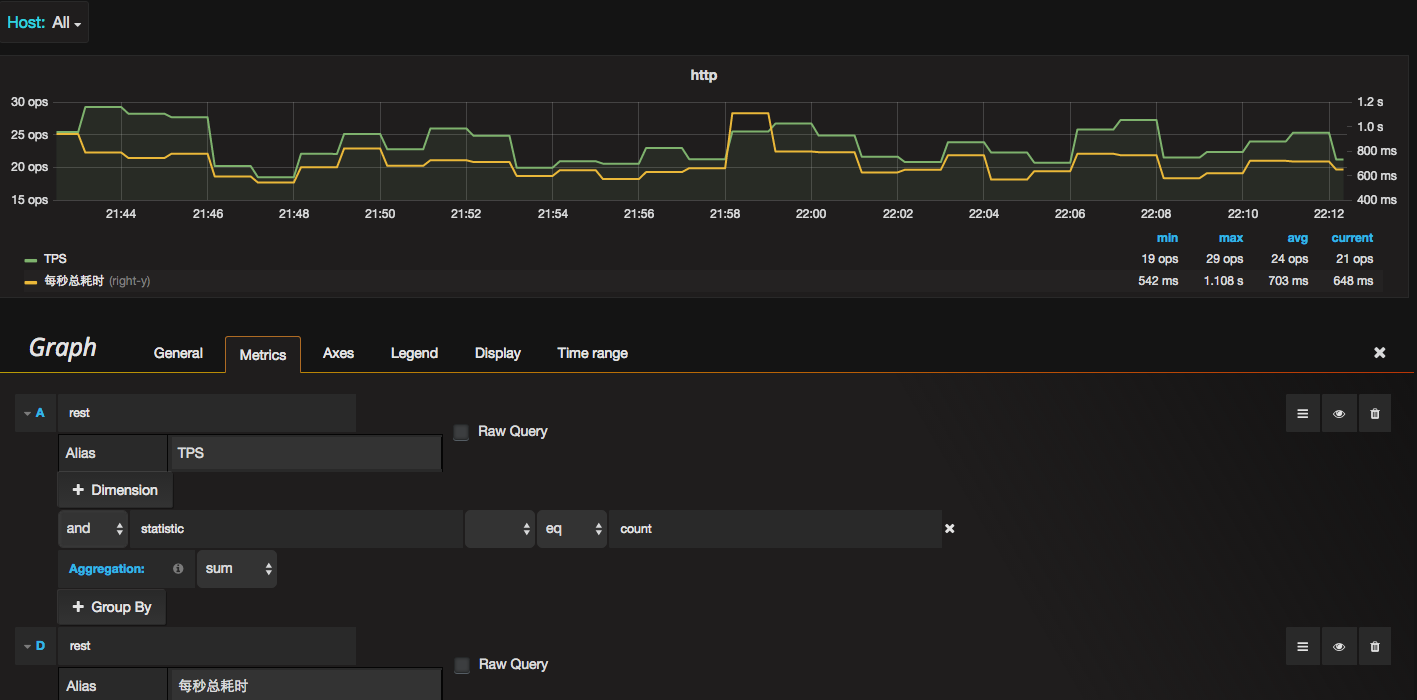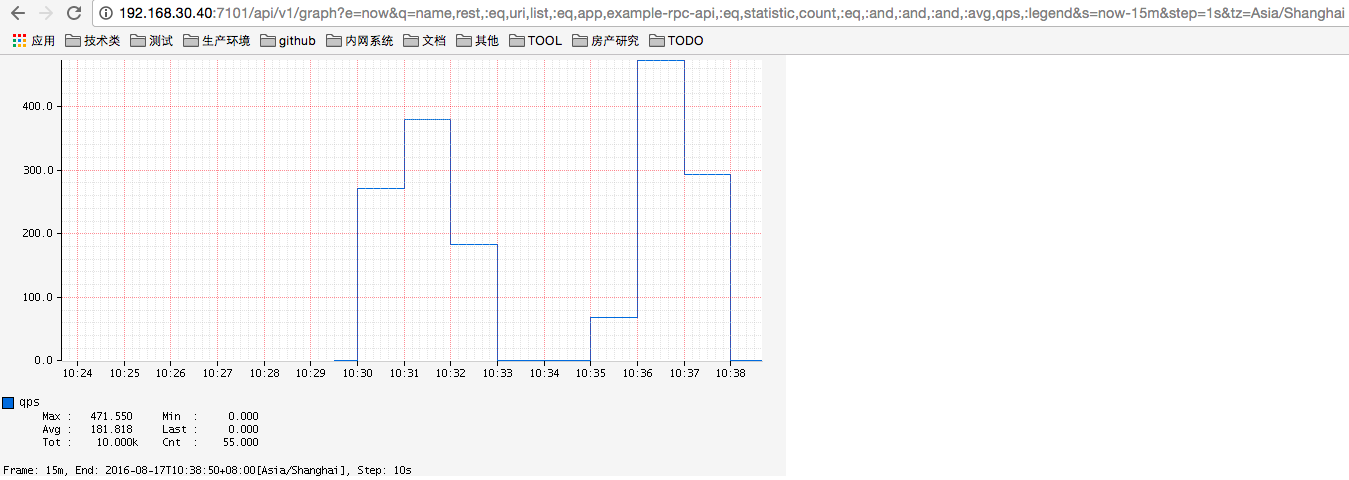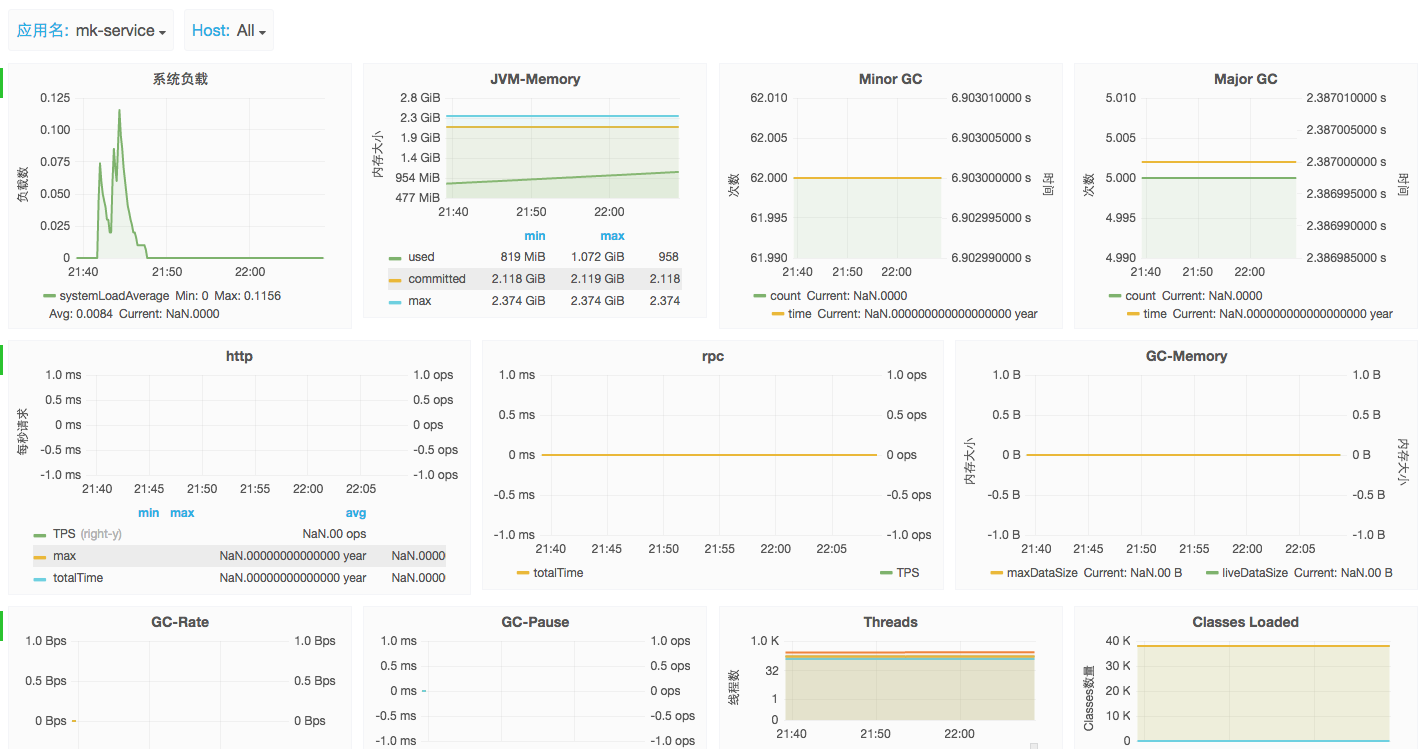转载请注明原创地址:http://my.oschina.net/u/2408085/blog/733900
平台组成
Atlas
Netflix开源的管理多维时序数据的metrics后端服务系统。可以用于汇总存储基于Spectator库收集到的metrics数据,并提供强大的查询语法,支持图表,json, 图片等格式返回。
Spectator
Netflix开源的用于收集metrics的lib库, 主要为了支持JDK8, 而用于替换同类旧产品Servo的项目。
具体用法参考http://netflix.github.io/spectator/en/latest/intro/counter/
Grafana
Grafana是灵活的Dashboard开源项目,可通过简单的配置自动画出对应数据源的图形。常用于实时监控系统的展示功能。
组合原理
应用通过Spectator收集metrics,并通过Atlas-client发送给Atlas, Grafana配置Atlas数据源和监控数据,实时从Atlas中获取时序数据。
搭建环境
Atlas
直接部署Netflix开源的Atlas,可独立运行的java包。由于需要grafana3-atlas-datasource的支持,同时为了更好的支持atlas json数据,需要Atlas 1.5.0+以上版本,官方release页面https://github.com/Netflix/atlas/releases 1.5.0+版本还未release。需要大家自行根据最新master代码编译打包。
$ curl -Lo memory.conf https://raw.githubusercontent.com/Netflix/atlas/master/conf/memory.conf
java -jar standalone-master.jar memory.conf
Grafana
打开http://grafana.org/download/页面,自行下载安装最新Grafana v3.X版本。
安装atals插件
感谢briangann提供的3.X插件(之前我测试使用的2.6版的插件),在3.X插件基础上我增加了对Grafana模板功能的支持,暂时还没和原版合并,大家可以自行选择。
git clone https://github.com/jewelknife/grafana3-atlas-datasource.git
mv grafana3-atlas-datasource /var/lib/grafana/plugins
# 重启grafana
程序新增依赖
默认应用程序已经集成springboot, springcloud。
// GC和JVM等扩展功能需要增加额外jar包,详见后面
<dependency>
<groupId>org.springframework.cloud</groupId>
<artifactId>spring-cloud-starter-spectator</artifactId>
</dependency>
<dependency>
<groupId>org.springframework.boot</groupId>
<artifactId>spring-boot-starter-actuator</artifactId>
</dependency>
<dependency>
<groupId>org.springframework.cloud</groupId>
<artifactId>spring-cloud-starter-atlas</artifactId>
</dependency>
增加全局tag配置
// 默认增加spring.application.name
@Configuration
public class AtlasTagProviderConfigration {
@Bean
AtlasTagProvider atlasCommonTags(@Value("${spring.application.name}") String appName) {
return () -> Collections.singletonMap("app", appName);
}
}
开启Atlas-client push功能
增加注解
@EnableAtlas
具体功能实现
TPS
spring-cloud-neflix-core 自带mvc接收请求,restful请求,httpclient请求等metrics记录功能。
其中记录mvc接受请求的拦截器为:
MetricsHandlerInterceptor.java
public class MetricsHandlerInterceptor extends HandlerInterceptorAdapter {
@Value("${netflix.metrics.rest.metricName:rest}")
String metricName;
@Value("${netflix.metrics.rest.callerHeader:#{null}}")
String callerHeader;
@Autowired
MonitorRegistry registry;
@Autowired
ServoMonitorCache servoMonitorCache;
@Autowired
Collection<MetricsTagProvider> tagProviders;
@Override
public boolean preHandle(HttpServletRequest request, HttpServletResponse response,
Object handler) throws Exception {
RequestContextHolder.getRequestAttributes().setAttribute("requestStartTime",
System.nanoTime(), SCOPE_REQUEST);
return super.preHandle(request, response, handler);
}
@Override
public void afterCompletion(HttpServletRequest request, HttpServletResponse response,
Object handler, Exception ex) throws Exception {
RequestContextHolder.getRequestAttributes().setAttribute("exception", ex,
SCOPE_REQUEST);
Long startTime = (Long) RequestContextHolder.getRequestAttributes().getAttribute(
"requestStartTime", SCOPE_REQUEST);
if (startTime != null)
recordMetric(request, response, handler, startTime);
super.afterCompletion(request, response, handler, ex);
}
protected void recordMetric(HttpServletRequest request, HttpServletResponse response,
Object handler, Long startTime) {
String caller = null;
if (callerHeader != null) {
caller = request.getHeader(callerHeader);
}
SmallTagMap.Builder builder = SmallTagMap.builder();
for (MetricsTagProvider tagProvider : tagProviders) {
Map<String, String> tags = tagProvider.httpRequestTags(request, response,
handler, caller);
for (Map.Entry<String, String> tag : tags.entrySet()) {
builder.add(Tags.newTag(tag.getKey(), tag.getValue()));
}
}
MonitorConfig.Builder monitorConfigBuilder = MonitorConfig.builder(metricName);
monitorConfigBuilder.withTags(builder);
servoMonitorCache.getTimer(monitorConfigBuilder.build()).record(
System.nanoTime() - startTime, TimeUnit.NANOSECONDS);
}
}
DefaultMetricsTagProvider.java
@Override
public Map<String, String> httpRequestTags(HttpServletRequest request,
HttpServletResponse response, Object handler, String caller) {
Map<String, String> tags = new HashMap<>();
tags.put("method", request.getMethod());
tags.put("status", ((Integer) response.getStatus()).toString());
String uri = (String) request
.getAttribute(HandlerMapping.BEST_MATCHING_PATTERN_ATTRIBUTE);
if (uri == null) {
uri = request.getPathInfo();
}
if (!StringUtils.hasText(uri)) {
uri = "/";
}
uri = sanitizeUrlTemplate(uri.substring(1));
tags.put("uri", uri.isEmpty() ? "root" : uri);
Object exception = request.getAttribute("exception");
if (exception != null) {
tags.put("exception", exception.getClass().getSimpleName());
}
if (caller != null) {
tags.put("caller", caller);
}
return tags;
}
上述代码可以看出,SpringCloud主要用Timer来记录Http请求,默认metricName为rest,可以通过配置"netflix.metrics.rest.metricName"进行修改。同时tags里增添了method,uri, status。 所以配置数据条件如下即可

Atlas里画出的图如下:

JVM内存相关
集成步骤
- 增加依赖
com.netflix.spectator:spectator-ext-jvm:0.40.0
- 初始化
import com.netflix.spectator.jvm.Jmx;
@Configuration
public class JvmMonitorConfigration {
@Autowired
public void setRegistry(Registry registry) {
Jmx.registerStandardMXBeans(registry);
}
}
Metrics
jvm.memory.used
当前使用的内存大小, 单位为bytes, 根据tags可以区分出6种:(这里有个注意点,tag的value存在空格,atlas和Spectator默认不支持)
- atlas.dstype=rate,id=Code Cache,memtype=NON_HEAP,policy=DefaultPublishingPolicy
- atlas.dstype=rate,id=Compressed Class Space,memtype=NON_HEAP,policy=DefaultPublishingPolicy
- atlas.dstype=rate,id=Metaspace,memtype=NON_HEAP,policy=DefaultPublishingPolicy
- atlas.dstype=rate,id=PS Eden Space,memtype=HEAP,policy=DefaultPublishingPolicy
- atlas.dstype=rate,id=PS Old Gen,memtype=HEAP,policy=DefaultPublishingPolicy
- atlas.dstype=rate,id=PS Survivor Space,memtype=HEAP,policy=DefaultPublishingPolicy
如上,可以根据id和memtype过滤指定"jvm.memory.used"值,memtype表示内存类型,它只有两个值HEAP和NON_HEAP。
jvm.memory.committed
当前可使用的内存大小(包括已使用的),单位为bytes,分类同上。(>=used) committed不足时jvm向系统申请,若超过max则发生OutOfMemoryError错误。
jvm.memory.max
最大可使用内存,单位为bytes,分类同上。(>=committed)
GC相关
集成步骤
- 增加依赖
com.netflix.spectator:spectator-ext-gc:0.40.0
- 初始化GCLogger
@Configuration
public class JvmMonitorConfigration {
// Keep a single instance of the logger
private GcLogger gc;
@Autowired
public void setRegistry(Registry registry) {
Spectator.globalRegistry().add(registry);
gc = new GcLogger();
gc.start(null);
}
}
Metrics
jvm.gc.allocationRate
年轻代GC回收内存速率,单位为bytes/second。回收的内存大小为youngGen.sizeBeforeGC - youngGen.sizeAfterGC。
jvm.gc.promotionRate
年轻代转移老年代速率,单位为bytes/second。转移的内存大小为abs(oldGen.sizeAfterGC - oldGen.sizeBeforeGC)
jvm.gc.liveDataSize
Full GC后老年代存活对象的大小,单位为bytes。
jvm.gc.maxDataSize
老年代最大大小,单位为bytes。
jvm.gc.pause
GC事件暂停时间,单位为:
-
statistic=max: seconds
-
statistic=count: events/second
-
statistic=totalTime: seconds/second
监控参考

遇到的问题
metrics长度过长被拒绝的问题
比如hystrix相关的metrics都很长。https://github.com/spring-cloud/spring-cloud-netflix/issues/798 按照Issue中回答修改配置可解决。
metrics tags的value效验不通过问题:
比如jvm的metrics中的value会有空格,而默认校验表达式为[\.\-\w]+,它不支持空格。client和server端都会效验, client端校验功能需要反射修改效验正则表达式,服务端可以通过配置去掉校验功能。
"timerCache is above the warning threshold of 1000 with size XXX"日志告警
这个告警主要是说创建的timer已经超过默认阈值1000了,可以通过增大配置netflix.metrics.servo.cacheWarningThreshold来解决。





















 482
482











 被折叠的 条评论
为什么被折叠?
被折叠的 条评论
为什么被折叠?








